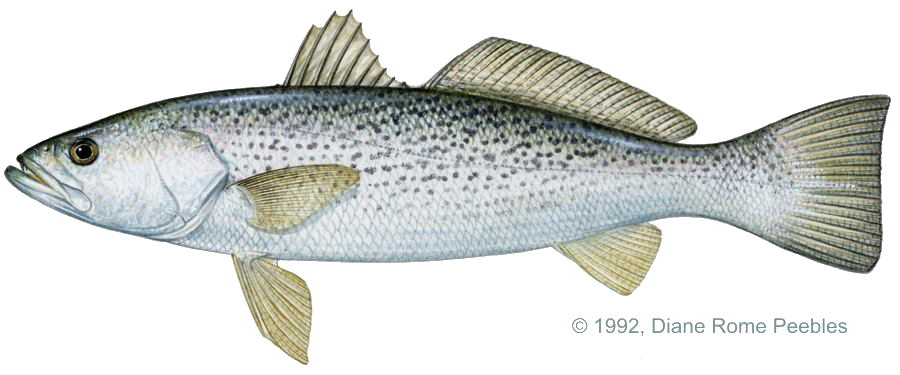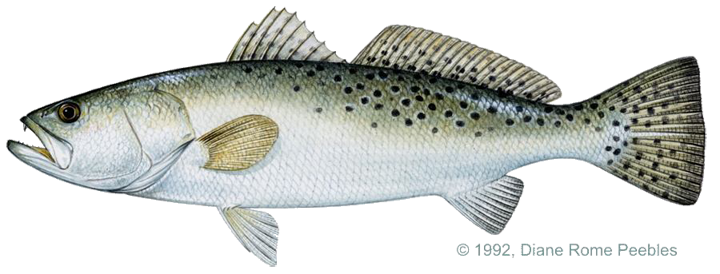Game Fish Identification Reference Guides
Weakfish
(Cynoscion regalis)
(Cynoscion regalis)

(Bloch & Schneider, 1801); SCIAENIDAE FAMILY; also called squeteague, common weakfish, common sea trout, gray trout, summer trout, tiderunner
Inhabits the western Atlantic Ocean from Florida to Massachusetts, with isolated records of it occurring as far north as Nova Scotia. The centers of abundance are from North Carolina to Florida in the winter and from Delaware to New York in the summer. It is a schooling fish that occurs in shore over sandy bottoms in the summer and in deeper water, up to 55 fathoms, in the winter. It may be found in the surf, in bays, or in estuaries of rivers and creeks, but does not venture into fresh water.
The name “weakfish” refers to the tender, easily torn membrane of the fish's mouth, rather than to its fighting ability. The lower jaw of the weakfish clearly projects beyond the upper jaw. Two large, recurvant canine teeth in the front of the upper jaw stand out noticeably. The first dorsal fin has 10 spines. The second has 1 spine and 26 29 soft rays. The anal fin has 2 spines and 11 12 rays. The scales are ctenoid and extend onto the soft dorsal and anal fins. In the similar looking spotted seatrout (Cynoscion nebulosus) the scales do not extend onto the fins. Also, there are 11 13 gill rakers on the lower limb of the first gill arch in the weakfish, but only 8 9 in the spotted seatrout. Numerous small spots of black, olive or bronze are set close together on the upper flanks of the weakfish and seem to form wavy diagonal lines. The spots do not extend onto the tail or the second dorsal fin as they do in the spotted seatrout, nor are they as large or as widely spaced. There is sometimes a black margin on the tip of the tongue.
It is omnivorous and feeds on crabs, shrimp, other crustaceans, mollusks and small fishes like herring, menhaden, silversides, killifish and butterfish which it may catch in midwater or at the surface.
They may be taken at any level from the bottom to the surface by chumming from a drifting or anchored boat or by trolling, jigging, or surf fishing. Conventional, spinning and fly tackle may be used. They may also be taken from bridges, docks and piers. When hooked on light tackle the weakfish is prone to give a long initial run with sudden, unpredictable changes in direction. It is reputed to be the gamest species of the Cynoscion genus.
The meat is white and tender with a high moisture content and the flavor is excellent. The skin is usually left on during cooking to hold the meat together and the bones are easily removed once the meat is cooked. It does not keep well and should be eaten soon after capture
Inhabits the western Atlantic Ocean from Florida to Massachusetts, with isolated records of it occurring as far north as Nova Scotia. The centers of abundance are from North Carolina to Florida in the winter and from Delaware to New York in the summer. It is a schooling fish that occurs in shore over sandy bottoms in the summer and in deeper water, up to 55 fathoms, in the winter. It may be found in the surf, in bays, or in estuaries of rivers and creeks, but does not venture into fresh water.
The name “weakfish” refers to the tender, easily torn membrane of the fish's mouth, rather than to its fighting ability. The lower jaw of the weakfish clearly projects beyond the upper jaw. Two large, recurvant canine teeth in the front of the upper jaw stand out noticeably. The first dorsal fin has 10 spines. The second has 1 spine and 26 29 soft rays. The anal fin has 2 spines and 11 12 rays. The scales are ctenoid and extend onto the soft dorsal and anal fins. In the similar looking spotted seatrout (Cynoscion nebulosus) the scales do not extend onto the fins. Also, there are 11 13 gill rakers on the lower limb of the first gill arch in the weakfish, but only 8 9 in the spotted seatrout. Numerous small spots of black, olive or bronze are set close together on the upper flanks of the weakfish and seem to form wavy diagonal lines. The spots do not extend onto the tail or the second dorsal fin as they do in the spotted seatrout, nor are they as large or as widely spaced. There is sometimes a black margin on the tip of the tongue.
It is omnivorous and feeds on crabs, shrimp, other crustaceans, mollusks and small fishes like herring, menhaden, silversides, killifish and butterfish which it may catch in midwater or at the surface.
They may be taken at any level from the bottom to the surface by chumming from a drifting or anchored boat or by trolling, jigging, or surf fishing. Conventional, spinning and fly tackle may be used. They may also be taken from bridges, docks and piers. When hooked on light tackle the weakfish is prone to give a long initial run with sudden, unpredictable changes in direction. It is reputed to be the gamest species of the Cynoscion genus.
The meat is white and tender with a high moisture content and the flavor is excellent. The skin is usually left on during cooking to hold the meat together and the bones are easily removed once the meat is cooked. It does not keep well and should be eaten soon after capture













